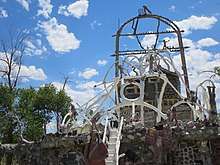Thunder Mountain Monument

The Thunder Mountain Monument is a series of outsider art sculptures and architectural forms that were assembled by Frank Van Zant starting in 1969 upon his arrival in Imlay, Nevada; it is located on a shoulder of I-80.
A World War II veteran from Oklahoma, Frank Van Zant had served with the 7th Armoured Division, fought in several campaigns in Europe,[1] and been badly burned in a tank battle outside Leipzig.[2] A self-identified Creek Indian,[3] he took the Native American name Rolling Mountain Thunder after experiencing an epiphany, and took on the twin but related tasks of both building shelters from the presumed coming apocalypse, and making a de facto spiritual haven for spiritual seekers of the hippie era. (There is no Thunder Mountain in the vicinity.)
The site covers five acres on the south side of a 1,000-foot stretch of Interstate 80. There were originally seven buildings, including a three-story hostel where many hippies stayed in the 1970s.[4] Three stone and concrete buildings remain, and more than 200 concrete sculptures depicting Native Americans and their protective spirits, massacres, and injustices against them. Thunder Mountain Monument (or Park) is replete with found objects, such as car hoods, dolls' heads, typewriters, and gas pumps, many of which are incorporated into the buildings themselves; one framework forms a large handle so the Great Spirit could take the building away after Thunder's death.[5]
The site was partially destroyed by arson in 1983,[5] the same year Van Zant was named Nevada's Artist of the Year; he committed suicide by shooting himself in the head in 1989. The monument was neglected and subject to vandalism until it was declared a Nevada State Historic Site in 1992; it is now under the care of his grown children under the aegis of a State of Nevada Historic Site Restoration Project, and is partially open to the public for self-guided tours.[6] Van Zant has been the subject of two short documentaries.[7]
References
- ↑ Menzies, Richard. "Background". Thunder Mountain. Retrieved 2016-02-15.
- ↑ "Imlay and Mill City, Nevada: History and Description". Nevadaweb.com. Retrieved 2011-12-26.
- ↑ "Thunder Mountain Park, Imlay, Nevada". Roadsideamerica.com. Retrieved 2011-12-26.
- ↑ "Frank Van Zant (Chief Rolling Mountain Thunder), Thunder Mountain Monument". Spaces. Retrieved 2016-02-15.
- 1 2 Ohlson, Kristin (April 8, 2010). "The Story of Thunder Mountain Monument". Smithsonian.
- ↑ "Thunder Mountain Monument". Agilitynut.com. Retrieved 2011-12-26.
- ↑ "Chief Rolling Mountain Thunder". Spyrock.com. Retrieved 2011-12-26.
External links
- Thunder Mountain Monument
- Thunder Mountain, Travel Nevada.com
- The Monument of Chief Rolling Mountain Thunder, documentary film
Coordinates: 40°39′36″N 118°08′01″W / 40.66004°N 118.1335032°W